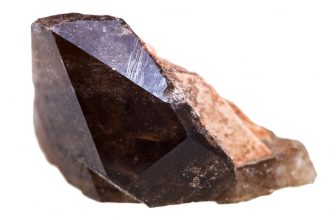Seer Stones
 A Glimpse Beyond the Ordinary
A Glimpse Beyond the Ordinary
Ever wonder how a simple stone could become a bridge between the seen and unseen?
For centuries, seer stones have occupied that curious space – where geology meets mysticism, and belief meets the tactile world.
In the most familiar historical sense, a seer stone refers to a small, polished rock said to help its user receive divine insight or “see” hidden truths. These stones gained special prominence in the early 19th century through Joseph Smith, founder of The Church of Jesus Christ of Latter-day Saints. Historical accounts describe him using such stones during spiritual translation work, most famously in the production of the Book of Mormon.
Yet beyond that single thread of religious history lies a wider, richer fabric. Seer stones are part of the “Crystals Shapes & Forms” universe because they combine physical artistry with profound symbolic purpose. Each curve, polish, and hue tells a story – not just of faith, but of form and human fascination.
So, what is it about a stone that invites someone to look for more than just its surface? What transforms a natural mineral into a conduit for revelation?
Let’s start with what we can actually see and touch – their physical form – before moving into the deeper mysteries they’ve carried across time.
The Shape and Substance of Seer Stones
A Stone That Fits the Hand – and the Imagination
Imagine finding an unassuming oval stone while digging a well. Earth-worn, smooth, chocolate-colored. That’s how one of Joseph Smith’s seer stones reportedly entered history – a small, egg-shaped stone, polished naturally by time and human touch. Its surface, described as “chocolate-brown” or “earth-toned,” offered no visible window into other worlds, yet to its owner, it was a portal.
Other accounts describe a pair of “interpreters” – two white, marble-like stones bound together with a silver bow, resembling spectacles. Whether used individually or as a set, these stones were not random geological finds; they were chosen, shaped, and revered for their potential to focus spiritual perception.
Their compact, curved forms made them ideal for scrying, the ancient practice of gazing into reflective surfaces to receive visions. A smooth oval stone fits naturally into the palm or cup of the hand, its weight grounding the body even as the mind drifts into subtler realms.
Materials that Hold Meaning
Descriptions vary, but most seer stones were opaque or lightly translucent, not glittering crystals in the modern sense. They might be feldspar, agate, or other common minerals – stones that felt earthy, not ostentatious. Their simplicity mattered.
Polished surfaces invited focus. Their egg-like shape symbolized birth, mystery, and inner potential – qualities resonant with spiritual renewal. The gentle curve of a seer stone wasn’t just aesthetic; it directed the gaze inward, concentrating attention in the same way a lens channels light.
The early “interpreters,” meanwhile, represented a different geometry. Two stones, side by side, mirrored the concept of dual vision – seeing both the physical and spiritual at once. This pairing may have symbolized balance between divine revelation and human understanding.
How Form Shaped Function
Accounts from early Latter-day Saint history describe a striking ritual scene: Joseph Smith placing the stone into a hat, pressing his face to the brim to block out external light. In the darkness, he reported seeing illuminated words or images appear on or through the stone.
From a purely material standpoint, this makes a strange kind of sense. By excluding light, the user heightened visual sensitivity – much like entering a cave and watching dim shapes emerge. The stone, polished to a subtle sheen, became a focal anchor in the dark, a mirror for imagination or inspiration.
Even skeptics note how the physical qualities – its small size, smooth texture, and portable shape – would naturally suit the task. The stone was both tool and symbol: easy to hold, easy to believe in.
The Story Behind the Seer Stone
Folk Magic on the Frontier
Have you ever noticed how, in times of uncertainty, people turn back to the earth – searching for signs in stones, water, or flame?
In early 19th-century America, this instinct thrived. Farmers, treasure seekers, and folk healers all participated in a lively world of folk magic, where belief and experimentation blurred. Within this landscape, seer stones were common tools. They were sometimes called peep stones or seeing stones, and they served one purpose: to reveal what ordinary eyes could not.
A person known as a seer might use such a stone to locate lost items, hidden treasure, or even spiritual truth. These practices were part of a wider European scrying tradition that had migrated to the American frontier, mingling with local folklore and Protestant mysticism. What we now view as quaint superstition once carried deep practical value.
Into this atmosphere stepped a young Joseph Smith. Before he became a religious leader, he participated in the same culture of stone-looking that shaped his neighbors’ lives. It wasn’t unusual; it was frontier normal. Yet from these common roots, something far larger would emerge.
Joseph Smith and His Stones
Historical sources tell us that Joseph Smith possessed at least two seer stones by his early twenties – one reportedly found while digging a well, another discovered later. These objects, so small they could fit in his hand, became instruments of revelation. According to both believers and critics, Smith used them to receive divine guidance, and ultimately, to translate the Book of Mormon.
Members of the early Church believed that through these stones, Smith could access spiritual sight, perceiving characters and meanings from sacred records. The physical act of peering into a stone – simple, repetitive, intensely focused – became central to this process.
Interestingly, other early church figures also owned seer stones, including Hiram Page and David Whitmer. This suggests a wider culture of stone-seeking within the movement’s formative years. What began as folk practice evolved, through faith and community, into sacred narrative.
From “Seer Stone” to “Urim and Thummim”
Over time, the terminology changed. The early phrase seer stone – so plainly magical – gave way to the more biblical Urim and Thummim. The shift wasn’t just linguistic. It represented a transformation in how the stones were perceived.
In the Old Testament, the Urim and Thummim were instruments of divine decision-making, held by the high priest. By associating the translation stones with that ancient image, the early Saints reframed them from folk artifacts into holy relics of prophetic authority. The material stayed the same; the meaning deepened.
This blending of folklore and theology illustrates a fascinating tension. Was revelation a mystical art or a sacred science? The name change didn’t erase that question – it polished it, much like the stones themselves.
Light, Controversy, and Continuing Curiosity
Of course, not everyone accepted this seamless fusion of magic and faith. Critics of the time accused Joseph Smith of blending superstition with religion, while defenders argued that divine communication naturally transcends ordinary categories.
Modern scholars continue to debate these origins, drawing on historical documents, eyewitness accounts, and the surviving stones themselves. Some see the seer stone tradition as a bridge between old-world folk practices and a new form of spiritual expression uniquely American. Others view it as evidence of cultural evolution – how something once marginal can become mainstream through the lens of faith.
Today, one of Joseph Smith’s brown seer stones resides in the archives of the Church of Jesus Christ of Latter-day Saints. Encased in glass, it has become both artifact and symbol – proof of history’s texture and belief’s endurance. Visitors often remark not on its power, but on its ordinariness. It looks like a stone you might skip across a pond. And maybe that’s the quiet lesson it leaves behind: revelation doesn’t always arrive in thunderclaps; sometimes, it’s the small, rounded thing that holds the infinite.
Symbolism and Spiritual Meaning of Seer Stones
Seeing What’s Hidden
We all crave clarity. Whether it’s understanding our emotions, our purpose, or the mystery of the universe, we long to see what lies beyond the fog. That longing – to see the unseen – is the essence of the seer stone.
Historically, these stones acted as literal tools of revelation. A seer would gaze into the stone, quieting the outer world to allow inner vision to rise. The process wasn’t unlike meditation: focus, darkness, reflection. The stone became a mirror, not for the face, but for the spirit.
In modern metaphysical language, we might call this scrying, a practice still alive among crystal enthusiasts today. But the seer stone tradition goes further – it suggests that spiritual insight isn’t found in what the stone shows, but in how we learn to look. The physical object simply helps us still the mind long enough for revelation to appear.
The Dance of Light and Shadow
Here’s a paradox worth savoring: Joseph Smith reportedly placed his stone in a hat to block out light – and in that darkness, words of light appeared. It’s a strange, beautiful metaphor. We sometimes find illumination only when we shut out the noise of the world.
The interplay between light and darkness has always defined seer stones. They are not transparent crystals meant to glitter in the sun, but opaque ones that invite inward focus. By reducing sensory distractions, they transform darkness into a kind of sacred canvas.
On a symbolic level, this act represents the dual nature of revelation. To see deeply, one must sometimes close the eyes. The stone becomes a threshold, a bridge between material and immaterial, between known and unknown.
Even the word “seer” evokes this tension – it implies both seeing and being seen by something greater. The stone doesn’t just reflect; it participates in revelation, mediating between human curiosity and divine communication.
Modern Resonance for Crystal Enthusiasts
For today’s collectors and crystal workers, seer stones offer more than historical fascination. They embody an ancient truth about attention and transformation. Many crystal enthusiasts use polished ovals – often quartz, calcite, or agate – as modern seer stones, meditating with them to spark intuition or clarity.
From a geological standpoint, their smoothness enhances tactile calm. From a symbolic one, their shape and opacity remind us to look inward rather than outward. Even if we remove the religious context, the function remains: a seer stone helps focus awareness.
Still, it’s important to approach them with respect for their historical roots. The stones connected to Joseph Smith and early Latter-day Saints carry sacred meaning for millions. When modern practitioners explore similar forms, it’s best to see it as learning from tradition, not borrowing it. The key is mindfulness – treating the stone as a partner in stillness, not a prop for spectacle.
Seer stones remind us that insight isn’t hidden in the heavens – it’s waiting quietly in the palm of your hand.
Stories Etched in Earth
The Brown Stone and the “Spectacles”
Among the most famous examples are Joseph Smith’s brown seer stone and the interpreters, sometimes called the Urim and Thummim. The brown stone, small enough to fit in a hand, was described as smooth and oval, with a gentle sheen. Found in the soil of upstate New York, it became one of the most unusual artifacts in American religious history.
The “interpreters,” by contrast, were two clear or white stones set in a frame like spectacles. Early accounts suggest they were attached to a breastplate and used during the initial stages of translation. These paired stones symbolized divine duality: perception through both mortal and spiritual eyes.
Together, these artifacts represent the evolution of seer practice – from folk scrying to organized theology, from humble stone to holy relic.
The Journey of the Stones
Over time, the brown seer stone passed through several hands before becoming part of the official archives of the Church of Jesus Christ of Latter-day Saints. It now rests in a protective case, preserved not just as a physical object but as a conversation piece between faith and history.
For some, it’s proof of a prophet’s inspiration. For others, it’s a window into 19th-century folk magic. Yet both perspectives share a kind of reverence – for the idea that meaning can be held in matter.































